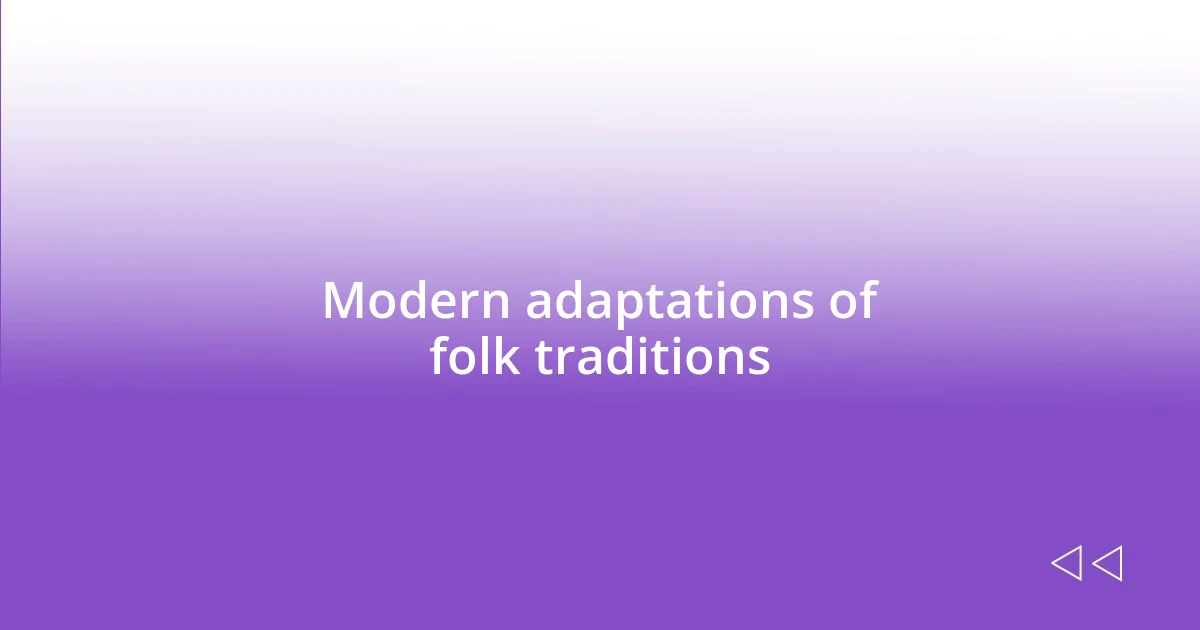Key takeaways:
- Folk traditions foster a sense of belonging and community identity through shared stories, music, and dances that connect individuals across diverse backgrounds.
- Modern adaptations of folk practices reinvent traditional art and music, making them relevant for younger generations and ensuring their continued relevance.
- Engaging with folk traditions enhances personal growth by fostering self-expression, healing, and deepening connections within the community.

Understanding the power of folk
Folk traditions hold immense power because they reflect the collective experiences and values of a community. I remember a chilly winter night sitting around a fire with friends, listening to stories passed down through generations. It struck me how these narratives not only entertained but also bound us together, creating a sense of belonging and shared identity.
There’s something uniquely comforting about folk music; a simple melody can evoke waves of emotion. Have you ever found yourself humming a tune that instantly transports you back to a cherished moment? I know I have, and it’s fascinating how a few notes can unlock memories and feelings, showcasing the deep connection we all share through these artistic expressions.
Exploring folk art helps us understand the everyday lives of those who came before us. When I stumbled upon an intricate quilt made by my grandmother, I felt an overwhelming sense of pride and connection with my roots. It’s incredible how folk traditions encapsulate history, culture, and personal stories, allowing us to honor and celebrate our past while inspiring future generations.

How folk influences community identity
Folk traditions play a critical role in shaping community identity by fostering a shared sense of belonging. I recall attending a local festival where everyone wore traditional clothing and participated in age-old dances. The atmosphere was electric, and I felt a deep sense of pride as neighbors came together to celebrate our shared history, reinforcing bonds that seemed to grow even stronger with each song sung and dance performed.
When I think about storytelling within folk culture, I’m reminded of the storytelling circle I joined a few years back. Each participant shared tales that reflected their individual backgrounds but also resonated with universal themes of love, loss, and perseverance. It was striking how, although we came from diverse backgrounds, these stories connected us, weaving a rich tapestry of community identity that felt both unique and inclusive.
In many ways, the legacy of folk traditions reminds us that we are part of something greater than ourselves. I often reflect on a summer camp where we would gather around a fire sharing folk songs. Those moments not only created lifelong memories but also instilled values of respect and unity among us. This is the essence of how folk influences community identity—through participation, shared experiences, and a commitment to preserving traditions for future generations.
| Aspect | Community Identity Impact |
|---|---|
| Tradition | Creates a sense of belonging and continuity. |
| Storytelling | Fosters connection through shared human experiences. |
| Art and Music | Reflects cultural values and provides a platform for expression. |

Modern adaptations of folk traditions
Modern adaptations of folk traditions breathe new life into age-old practices, keeping them relevant in today’s world. I recall attending a contemporary dance workshop that fused traditional folk movements with modern choreography. It was fascinating to see how dancers creatively interpreted classic steps, infusing their individual styles while respecting the roots of the dance. Such adaptations not only honor tradition but also invite new generations to engage with these rich cultural tapestries.
- Folk music festivals now often showcase a blend of traditional and modern genres, making the sounds relatable and exciting for younger crowds.
- Artisans are incorporating modern materials and techniques into their crafts, ensuring that traditional methods don’t become static relics.
- Social media platforms have enabled folk stories and crafts to reach wider audiences, allowing local artists to thrive and connect globally.
I remember being struck by an artwork in an exhibition that combined traditional weaving techniques with contemporary design. The artist’s passion was palpable as they explained how they honored their cultural legacy by merging it with today’s aesthetic values. It’s moments like these that remind me how adaptable and enduring folk traditions can be.

Embracing folk for personal growth
Embracing folk traditions has profoundly influenced my personal growth. I still vividly recall my first experience with a community drum circle. As I struck my drum alongside others, I felt an exhilarating sense of freedom and connection. The rhythm pulsed with life, and I realized that participating in something ancient allowed me to shed layers of self-doubt, revealing a more authentic version of myself.
There’s a remarkable power in learning traditional crafts that resonate with my heritage. I took up pottery after a workshop, where I shaped clay not just with my hands but with my heart. Each piece I created told a story of resilience and patience, serving as a reminder that growth often comes from embracing imperfections. Isn’t it captivating how folk practices, rooted in our histories, can provide avenues for self-expression and healing?
What strikes me is the sense of community that blossoms when we engage with folk traditions. I often find myself reflecting on how singing folk songs with friends not only strengthens our friendship but also nurtures our individual journeys. Those gatherings, filled with laughter and harmonies, become sanctuaries for personal reflection and growth. Can you imagine how such shared experiences might enrich your own life? I believe they create echoes that encourage us to explore our identities deeper and thrive together.














